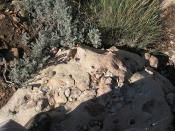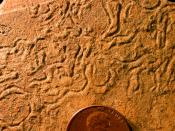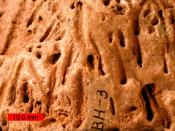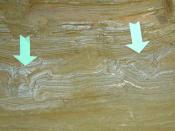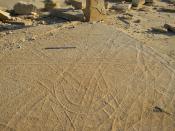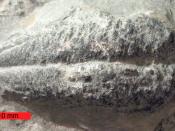A fossil is the remains of ancient animals and plants, the traces of impression of living things from past geologic ages, or the traces of their activities. Fossils have the same shape that the original item had.
Fossilization is the process that turns a once living thing into a fossil. There are lots of fossils to be found, but only a tiny number of all the animals and plants that ever lived have been fossilized.
Trace fossils are one of the preserved fossils, they are non-body remains indicating the behavior of an organism. They can represent plants or animals, for example footprints, trails, eggs and etc.
Trace fossils gives us proof of animal life from the past. Modern traces are all around us, for example Dogs leave paw prints in the mud.
Trace fossils provide palaeontologists with evidence of the activities of ancient. Trace fossils are formed in place and can therefore tell us about the ancient environment in which the animal lived.
One single animal can make thousands and thousands of traces in its lifetime, but it will only leave behind one body when it dies. Because of this, trace fossils are much more common than body fossils.
Trace fossils are moments of time that have been captured forever in the rock record.
There are different types of Trace Fossils such as:Track - an impression made by a single foot.
Trackway - a number of tracks made during a single trip.
Trail - an impression made by an animal without legs.
Burrows - a hole or holes an animal dug into loose sediment (like mud).
Trace fossils most often were created in soft sediments, and are usually preserved only if the sediment remains undisturbed until it has become rock. Trace fossils have been found in rocks as far back as the Late Precambrian.
Three species of mammoths lived on the mainland of United States at the end of the last ice age. These were the Columbian Mammoth, Jefferson's Mammoth and Wooly Mammoth. Jefferson's Mammoth and Wooly Mammoth have been identified from the Midwestern United States.
The mammoths are closely related to elephants especially the Indian Elephant. Mammoths are found in fossils in the Midwestern United States most often isolated teeth are found. Mammoth fossils are most common in areas that were covered by savannas, grasslands, or tundra during the last ice age.
Columbian MammothMammoths had their start in the Pleistocene Age (around 2 million years ago) and became extinct at the end of the last ice age, about 10,000 years ago. Remains of Mammoths have been found amazingly preserved in ice.
